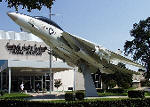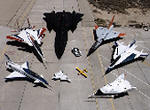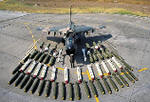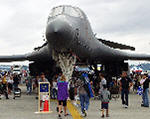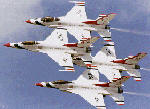
|
Description
| Manufacturer: | Ryan | |
| Base model: | V-5 | |
| Designation: | XV-5 | |
| Version: | A | |
| Designation System: | U.S. Air Force | |
| Designation Period: | 1956-Present | |
| Basic role: | V/STOL | |
| Status: | Experimental | |
Specifications
| Not Yet Available |
Recent comments by our visitors
| Lindsey Everett San Diego, CA | @ "Cole" Everett - the inaccuracies in your screenname are astounding. Your name is not "Cole" which you would know if you looked at your birth certificate DAMON. I'm telling mom.
06/06/2011 @ 20:32 [ref: 39201] |
| Elva Maddry Dry Prong, LA | I was the secretary for the XV-5A test program at Edwards Air Force Base. I took a lot of dictation from the test pilots, Lou Everett being one of them. I typed the flight reports for the pilots after each test.
I had moved when I heard of the tragic death of Lou Everett on Press Day. He was a pleasure to work for, and I was deeply saddened by the crash of this plane. Elva Maddry 3277 Hwy 472 Dry Prong, LA 71423 10/14/2008 @ 14:35 [ref: 22855] |
| chicbiz , FL | I have a really cool vinyl record that I just posted on ebay from 1962 detailing the XV-5A. It's a one of a kind recording and a must for the enthusiast. You can find it under:
Kaleidoscope- KMX News- Radio Recorders 12" LP- XV-5A Check it out! 04/24/2008 @ 07:34 [ref: 20690] |
| Greg Heinen Los Angeles, CA | I would like to get some pictures of the XV-5A Tip Turbine Fans, particularly in the area of the tip turbine, not so much the gas generators. Anything would be appreciated. These are GE designs. There are some contrasting engine designations based on whether one is referring to the 5A or 5B. Here is what I have:
XV-5 Vertifan Specifications Length 13.5m / 44 ft Wing Span 9.1m / 30 ft Height 4.5m All-Up Weight 5,580Kg / 12,200 lb Engine 2 General Electric J85-GE-5 @ 2,650 lbst Max Speed 880Km/h Range 1,160Km Service Ceiling 12,200m Crew 1 General Electric YT58-GE-2 VZ-11RY Vertifan Ryan 2 General Electric J85-GE-5 2 XV-5A 08/18/2005 @ 13:53 [ref: 11018] |
| Cole Everett Pullman, WA | Zodyak Washington from Cazo, DC posted the following:
The ryan was originnaly a AC130 Hercules.It hovers by the wings Twisting UpRight but it needs to slow down.Here Are The Specifications. Lockheed AC-130A 'Hercules' Description Manufacturer: Ryan Base model: V-8 Designation: XV-8 Version: A Nickname: Fleep The inaccuracies here are astounding. Visiting them categorically... First "the ryan" was not originally an AC-130 Hercules. Nor is the AC-130 designated the Hercules, it is the Spectre, a gunship. The Hercules and Spectre are not VTOL planes. Second this plane is devoted to the XV-5A Vertifan. The Vertifan as pointed out below by Bob Graham was piloted by Lou Everett who died in the plane. Third, the Fleep did not resemble an AC-130 or the XV-5A. It was the follow up to the Flex Wing. Both the Fleep and the Flex Wing had a wing that most would recognize as today's hang-gliders. It was not a VTOL but a STOL. It was small and lightweight and had a single propeller. Both the Flex Wing and Fleep were piloted by Lou Everett. This person could have seen the XC-142 which Ryan participated in. It did have a tilt wing with 4 engines. It had a similar mission as the V-22 Osprey of cargo and troop transport. 03/26/2005 @ 08:21 [ref: 9801] |
| Steve & Corine Galeener Bellflower, CA | To commemorate the Air Force Flight Test Center, which was established June 25, 1951, the AFFTC History Office recalled some of the milestones in flight that took place here during the last half century.
By Dr. Raymond L. Puffer Air Force Flight Center historian Aviation designers have been working on the concept of vertical and short takeoff and landing (V/STOL) aircraft for many years. There are a number of different ways to combine a helicopter's lift with the performance of a conventional airplane, but developing a practical and successful hybrid aircraft has proven to be a surprisingly difficult task. Numerous approaches have been explored over the years, of which the two Joint Strike Fighter concept demonstrators are only the latest. There have been tilt-rotors like the CV-22 Osprey, tilt-props and tilt-wings, as well as deflected-slipstreams, deflected-thrust, thrust augmentors, and tailsitters. Many of these exotic designs have been tested at Edwards, and Air Force Flight Test Center pilots have often been called to fly some extremely unusual aircraft. On Aug. 13,1965, Maj. Robert L. Baldwin lifted an oddly humpbacked brown jet into the air and began the Air Force Flight Evaluation of the GE-Ryan XV-5A. General Electric had been researching a fan-in-wing concept for V/STOL aircraft, and late in 1961 it won an Army contract for a concept demonstrator. GE subcontracted the design and construction work to Ryan. The XV-5A that resulted was a small, fighter-like design: 44 feet long with a 30-foot wingspan. A pair of J85-GE-5 turbojets mounted in the fuselage spine provided approximately 5,000 pounds of thrust in normal flight. When vertical thrust was needed, the pilot could actuate a diverter valve that directed some of the exhaust gases to a pair of fans, 5 feet in diameter, located in the inboard portion of each wing. The wing fans rotated in opposite directions and were covered by large hinged doors in conventional flight. Exhaust gas also powered a smaller fan in the nose that provided pitch control and a measure of additional lift. All three fans together provided 16,000 pounds of vertical thrust. A set of louvered vanes underneath each of the large wing fans could vector the thrust in any direction and provided yaw control. The XV-5A was essentially an Army project, and the AFFTC's role was mission support. This always involves a lot more than just letting the Responsible Test Organization (RTO) use the runways and fire trucks. In this instance, the Flight Test Center provided weight and balance facilities, chase and pace aircraft, photography coverage, fuel and lubricants, instrumentation and calibration lab facilities, power plant services, the thrust stand, theodolite and telemetry coverage, and parachute facilities. AFFTC pilots flew the two XV-5A's on many occasions and built up a lot of expertise. During the Air Force evaluation phase, Baldwin found over the course of 15 sorties that the little jet had a large airspeed envelope, from total hover to speeds in excess of 400 knots. It was "…stable, easy to control, and a pleasure to fly," at least in most of its flight envelope. However the changeover from horizontal to vertical flight (or vice-versa) was abrupt and occurred in one stage — this made for tricky handling in the air. All in all, though, the XV-5A had turned out to be a promising concept. Why, then, didn't some equivalent of the AV-8 Harrier or the X-35 appear decades earlier? The lift fan system was heavy and required too much internal volume, and service pilots would have difficulty with the narrow transition zone. After a series of accidents, the Army and the Air Force lost interest and soon it became literally a case of "back to the drawing board." Edwards Air Force Flight Test Center Moments In Flight Test History 03/01/2005 @ 17:08 [ref: 9576] |
| Zodyak Washington Cazo, DC | The ryan was originnaly a AC130 Hercules.It hovers by the wings Twisting UpRight but it needs to slow down.Here Are The Specifications.
Lockheed AC-130A 'Hercules' Description Manufacturer: Ryan Base model: V-8 Designation: XV-8 Version: A Nickname: Fleep Designation System: U.S. Air Force Designation Period: 1956-Present Basic role: V/STOL Status: Experimental Specifications Length: 97' 8" 29.7 m Height: 38' 5" 11.7 m Wingspan: 132' 6" 40.3 m Wingarea: 1,745.5 sq ft 162.1 sq m Empty Weight: 59,328 lb 26,906 kg Gross Weight: 108,000 lb 48,979 kg Max Weight: 124,200 lb 56,326 kg Propulsion No. of Engines: 4 Performance Max Speed: 390 mph 628 km/h Ceiling: 31,350 ft 9,555 m 03/01/2005 @ 12:48 [ref: 9572] |
| Bob Graham Downers Grove, IL | It should be noted that test pilot Lou Everett lost his life in the testing of this plane for Ryan in 1965 (66?) in San Diego. Analysis indicated that he had unknowingly tripped a switch with his glove. When things began to go wrong, he went back and reversed the last thing he THOUGHT he had done, thus compounding the problem.
Lou and his family went to my church and I went to school with his son, Tom. If anybody has any idea of how I could reach the family I would appreciate it. 10/08/2004 @ 11:26 [ref: 8411] |
Recent photos uploaded by our visitors
